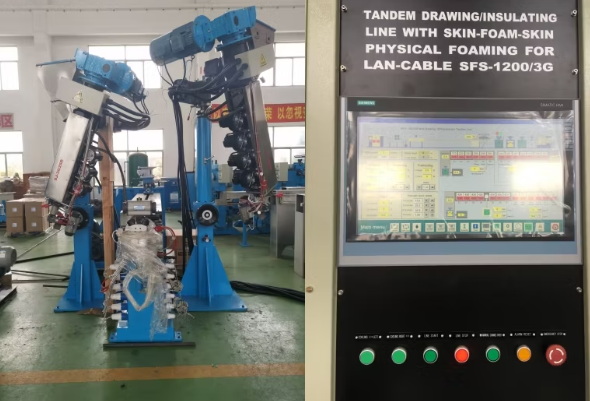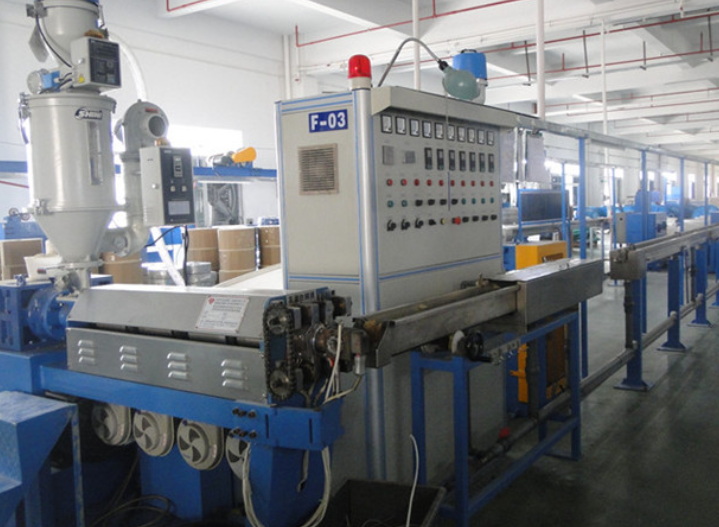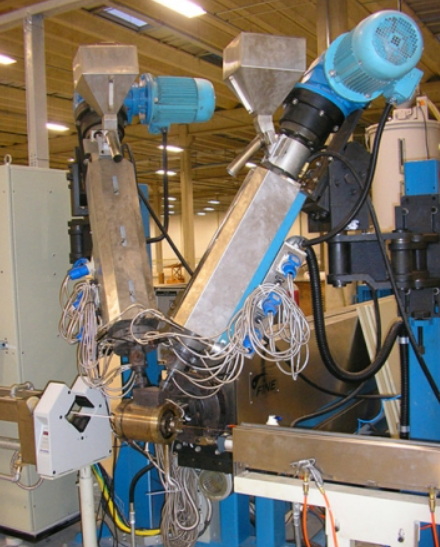Content Menu
● Understanding Skin-Foam-Skin Technology
● Advantages of Skin-Foam-Skin Insulation
● Applications of Skin-Foam-Skin Technology
● The Process of Tandem Extrusion
>> Key Parameters in Tandem Extrusion
● Quality Control Measures
● Challenges and Solutions
● Future Trends in Skin-Foam-Skin Technology
● Conclusion
● FAQ
>> 1. What is Skin-Foam-Skin insulation technology?
>> 2. How does tandem extrusion work?
>> 3. What are the benefits of using Skin-Foam-Skin technology in electrical cables?
>> 4. Can Skin-Foam-Skin technology be applied to sustainable materials?
>> 5. What challenges are associated with Skin-Foam-Skin production?
● Citations:
The Skin-Foam-Skin (SFS) insulation tandem extrusion technology represents a significant advancement in the field of polymer processing, particularly in the production of high-performance insulation materials. This innovative approach combines layers of solid material with a foamed core, resulting in products that exhibit enhanced mechanical properties, thermal insulation, and overall performance. This article explores the intricacies of this technology, its advantages, and its applications, particularly focusing on the China skin-foam-skin insulation tandem extrusion production line.

Understanding Skin-Foam-Skin Technology
The Skin-Foam-Skin structure involves three distinct layers:
- Outer Skin Layer: A solid polymer layer that provides mechanical protection and enhances adhesion to the outer environment.
- Foam Core: A lightweight, insulating layer that reduces thermal conductivity and weight while maintaining structural integrity.
- Inner Skin Layer: Similar to the outer skin, this layer encapsulates the foam core, providing additional support and preventing moisture ingress.
This tri-layer construction is achieved through tandem extrusion, where multiple extruders work in concert to produce a continuous product with uniform properties.
Advantages of Skin-Foam-Skin Insulation
The SFS technology offers several key advantages that enhance product quality:
- Improved Mechanical Stability: The solid outer layers protect the foam core from mechanical stresses during handling and installation. This stability is crucial for applications in cables and other structural components.
- Enhanced Thermal Performance: The foam core significantly reduces thermal conductivity compared to solid materials, making it ideal for insulation applications. This characteristic is particularly beneficial in energy-efficient building materials.
- Weight Reduction: By incorporating a foamed structure, products can achieve lower weights without compromising strength. This aspect is essential in industries where weight is a critical factor, such as aerospace and automotive.
- Low Insertion Loss: In cable manufacturing, SFS technology minimizes signal loss during transmission, which is vital for maintaining performance in high-speed data applications.
Applications of Skin-Foam-Skin Technology
The SFS insulation technology finds applications across various industries:
- Electrical Cables: Used extensively in data cables (e.g., Cat 6A to Cat 8), where low insertion loss and high mechanical stability are essential.
- Construction Materials: Employed in insulation panels for buildings, providing superior thermal performance while reducing overall material costs.
- Automotive Components: Used in lightweight structural components that require both strength and insulation properties.
The Process of Tandem Extrusion
Tandem extrusion involves multiple extruders aligned in series. Each extruder serves a specific function:
1. Main Extruder: Responsible for melting and mixing the polymer with any additives required for foaming.
2. Skin Extruders: These extruders apply the outer skin layers to encapsulate the foam core. They must maintain precise control over thickness to ensure uniformity.
3. Crosshead Die: This component combines the materials from the different extruders into a single profile with the desired skin-foam-skin structure.
Key Parameters in Tandem Extrusion
Several parameters influence the quality of products produced through tandem extrusion:
- Temperature Control: Maintaining optimal temperatures throughout the process ensures proper melting and foaming characteristics.
- Pressure Management: Adequate pressure must be maintained during gas injection to achieve uniform foaming without defects.
- Cooling Rates: Effective cooling is crucial for stabilizing the foam structure after extrusion.

Quality Control Measures
To ensure high-quality outputs from skin-foam-skin production lines, several quality control measures are implemented:
- Real-Time Monitoring Systems: Advanced sensors monitor parameters such as temperature, pressure, and dimensions throughout the extrusion process.
- Material Testing: Regular testing of mechanical properties (e.g., tensile strength, elasticity) ensures that products meet industry standards.
- Visual Inspections: Automated systems can detect surface defects or inconsistencies in thickness that may affect performance.
Challenges and Solutions
While SFS technology offers numerous benefits, challenges remain:
- Complexity of Process Control: The need for precise control over multiple variables can complicate operations. Implementing advanced automation systems can mitigate this issue by providing real-time adjustments based on sensor feedback.
- Material Compatibility: Not all polymers are suitable for foaming or tandem extrusion. Research into compatible materials can expand the range of applications for SFS technology.
Future Trends in Skin-Foam-Skin Technology
As industries continue to seek more efficient materials, future advancements may include:
- Biodegradable Foams: Research into sustainable materials could lead to eco-friendly alternatives that maintain performance while reducing environmental impact.
- Smart Insulation Materials: Incorporating sensors within the foam structure could allow for real-time monitoring of thermal performance or structural integrity.
Conclusion
The Skin-Foam-Skin insulation tandem extrusion technology significantly enhances product quality through improved mechanical stability, thermal performance, and weight reduction. Its application across various industries demonstrates its versatility and importance in modern manufacturing processes. As advancements continue to emerge, SFS technology will likely play an even more critical role in developing high-performance materials tailored to meet evolving industry demands.

FAQ
1. What is Skin-Foam-Skin insulation technology?
Skin-Foam-Skin insulation technology involves creating a composite material with an outer solid skin layer, a foamed core for insulation, and another solid skin layer on the inside. This structure enhances mechanical stability and thermal performance.
2. How does tandem extrusion work?
Tandem extrusion utilizes multiple extruders aligned in series to produce a continuous product with different layers. Each extruder serves a specific purpose—melting polymers or applying skin layers—resulting in a composite material with desired properties.
3. What are the benefits of using Skin-Foam-Skin technology in electrical cables?
The main benefits include reduced insertion loss during signal transmission, increased mechanical stability against external stresses, and improved thermal insulation properties which enhance overall cable performance.
4. Can Skin-Foam-Skin technology be applied to sustainable materials?
Yes, ongoing research is exploring biodegradable polymers that can be used within SFS structures without sacrificing performance while also reducing environmental impact.
5. What challenges are associated with Skin-Foam-Skin production?
Challenges include maintaining precise control over processing parameters due to the complexity of tandem extrusion and ensuring material compatibility for effective foaming processes. Implementing advanced monitoring systems can help address these issues.
Citations:
[1] https://www.lorom.com/capability/bulk-cable-manufacturing/high-speed-low-loss-dielectric-extrusion/
[2] https://www.natureworksllc.com/~/media/Technical_Resources/Processing_Guides/ProcessingGuide_Foam-Sheet-Extrusion_pdf.pdf
[3] https://www.extrusionconsultinginc.com/quality-issues-in-foam-extrusion.html
[4] https://hoohaco.en.made-in-china.com/product/qtVRKONDfzhu/China-Skin-Foam-Skin-Triple-Layer-Physical-Foaming-Tandem-Line-Category7-Category8-Extrusion-Machine.html
[5] https://www.linttop.com/professional-design-skin-foam-skin-insulation-tandem-extrusion-production-line-high-speed-double-twist-buncher-lint-top.html
[6] https://pubs.acs.org/doi/10.1021/bk-2023-1440.ch001
[7] https://www.mdpi.com/2073-4360/11/2/306
[8] https://www.linttop.com/drawing-annealer-pre-heating-insulation-tandem-extrusion-production-line.html
[9] https://pmc.ncbi.nlm.nih.gov/articles/PMC11085284/






















